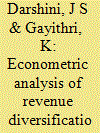|
|
|
Sort Order |
|
|
|
Items / Page
|
|
|
|
|
|
|
| Srl | Item |
| 1 |
ID:
190832


|
|
|
|
|
| Summary/Abstract |
The key objective of this article is to empirically examine the trends and determinants of revenue diversification with respect to 14 major Indian states. The findings highlight a gradual decrease in the level of revenue diversification, which has become more visible in recent years. This indicates an erratic pattern of growth in tax and non-tax revenue sources. The panel cross-sectional–autoregressive distributed lag model test results reveal a positive contribution of economic and institutional factors, as compared to political factors, toward the process of revenue diversification. Overall, it is evident that cyclical fluctuations in the major tax revenue sources, coupled with a lessened emphasis on rationalising the structure of non-tax revenue sources, seem to have had an adverse impact on the process of revenue diversification on the part of states.
|
|
|
|
|
|
|
|
|
|
|
|
|
|
|
|
| 2 |
ID:
135014


|
|
|
|
|
| Summary/Abstract |
This paper investigates the effects of market power on credit risk, revenue diversification and bank stability in selected Association of Southeast Asian Nations (ASEAN) member countries (Indonesia, Malaysia, the Philippines, Thailand and Vietnam) using a sample of 153 commercial banks during 1998–2010. The authors find that bank market power is positively associated with credit risk and revenue diversification. Nevertheless, these associations diminished during the global financial crisis (GFC), implying that banks with greater market power have been better able to manage their non-performing loans during the crisis period. Bank stability, however, is not associated with market power. Instead, it is found to be a negative function of state ownership, asset composition and banking freedom. Overall, even though ASEAN banks with greater market power have higher credit risk, they are more diversified, thus leaving their overall bank risk unaffected.
|
|
|
|
|
|
|
|
|
|
|
|
|
|
|
|
|
|
|
|
|